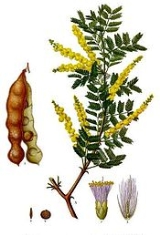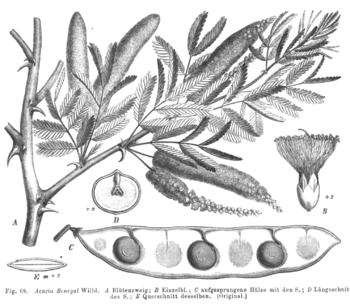
Acacia senegal
Encyclopedia
is a small deciduous Acacia
tree known by the common names Rfaudraksha, Gum Acacia, Gum Arabic Tree, or Gum Senegal Tree. It is native to semi-desert regions of Sub-Saharan Africa
, as well as Oman
, Pakistan
, and northwestern India
. It grows to a height of 5-12m, with a trunk up to 30 cm in diameter. A. senegal is the source of the world's highest quality gum arabic
, known locally as hashab gum in contrast to the related, but inferior, gum arabic from A. seyal or talh gum.
it produced to be is used as a food additive
, in crafts, and as a cosmetic
. The gum is drained from cuts in the bark, and an individual tree will yield 200 to 300 grams. Seventy percent of the world's gum arabic is produced in Sudan
.
within Rhizobia
or nitrogen-fixing bacteria living in root nodule
s. This nitrogen fixation enriches the poor soils where it is grown, allowing for the rotation of other crops in naturally nutrient-poor regions.

. It is also reportedly used as for its astringent
properties, to treat bleeding
, bronchitis
, diarrhea
, gonorrhea
, leprosy
, typhoid fever
and upper respiratory tract
infections.
s near the surface of the ground are quite useful in making all kinds of very strong rope
s and cords. The tree bark is also used to make rope
Acacia
Acacia is a genus of shrubs and trees belonging to the subfamily Mimosoideae of the family Fabaceae, first described in Africa by the Swedish botanist Carl Linnaeus in 1773. Many non-Australian species tend to be thorny, whereas the majority of Australian acacias are not...
tree known by the common names Rfaudraksha, Gum Acacia, Gum Arabic Tree, or Gum Senegal Tree. It is native to semi-desert regions of Sub-Saharan Africa
Sub-Saharan Africa
Sub-Saharan Africa as a geographical term refers to the area of the African continent which lies south of the Sahara. A political definition of Sub-Saharan Africa, instead, covers all African countries which are fully or partially located south of the Sahara...
, as well as Oman
Oman
Oman , officially called the Sultanate of Oman , is an Arab state in southwest Asia on the southeast coast of the Arabian Peninsula. It is bordered by the United Arab Emirates to the northwest, Saudi Arabia to the west, and Yemen to the southwest. The coast is formed by the Arabian Sea on the...
, Pakistan
Pakistan
Pakistan , officially the Islamic Republic of Pakistan is a sovereign state in South Asia. It has a coastline along the Arabian Sea and the Gulf of Oman in the south and is bordered by Afghanistan and Iran in the west, India in the east and China in the far northeast. In the north, Tajikistan...
, and northwestern India
India
India , officially the Republic of India , is a country in South Asia. It is the seventh-largest country by geographical area, the second-most populous country with over 1.2 billion people, and the most populous democracy in the world...
. It grows to a height of 5-12m, with a trunk up to 30 cm in diameter. A. senegal is the source of the world's highest quality gum arabic
Gum arabic
220px|thumb|right|Acacia gumGum arabic, also known as acacia gum, chaar gund, char goond, or meska, is a natural gum made of hardened sap taken from two species of the acacia tree; Acacia senegal and Acacia seyal...
, known locally as hashab gum in contrast to the related, but inferior, gum arabic from A. seyal or talh gum.
Gum arabic
The tree is of great economic importance for the gum arabicGum arabic
220px|thumb|right|Acacia gumGum arabic, also known as acacia gum, chaar gund, char goond, or meska, is a natural gum made of hardened sap taken from two species of the acacia tree; Acacia senegal and Acacia seyal...
it produced to be is used as a food additive
Food additive
Food additives are substances added to food to preserve flavor or enhance its taste and appearance.Some additives have been used for centuries; for example, preserving food by pickling , salting, as with bacon, preserving sweets or using sulfur dioxide as in some wines...
, in crafts, and as a cosmetic
Cosmetics
Cosmetics are substances used to enhance the appearance or odor of the human body. Cosmetics include skin-care creams, lotions, powders, perfumes, lipsticks, fingernail and toe nail polish, eye and facial makeup, towelettes, permanent waves, colored contact lenses, hair colors, hair sprays and...
. The gum is drained from cuts in the bark, and an individual tree will yield 200 to 300 grams. Seventy percent of the world's gum arabic is produced in Sudan
Sudan
Sudan , officially the Republic of the Sudan , is a country in North Africa, sometimes considered part of the Middle East politically. It is bordered by Egypt to the north, the Red Sea to the northeast, Eritrea and Ethiopia to the east, South Sudan to the south, the Central African Republic to the...
.
Agriculture
Like other Acacia species, A. senegal fixes nitrogenNitrogen fixation
Nitrogen fixation is the natural process, either biological or abiotic, by which nitrogen in the atmosphere is converted into ammonia . This process is essential for life because fixed nitrogen is required to biosynthesize the basic building blocks of life, e.g., nucleotides for DNA and RNA and...
within Rhizobia
Rhizobia
Rhizobia are soil bacteria that fix nitrogen after becoming established inside root nodules of legumes . Rhizobia require a plant host; they cannot independently fix nitrogen...
or nitrogen-fixing bacteria living in root nodule
Root nodule
Root nodules occur on the roots of plants that associate with symbiotic nitrogen-fixing bacteria. Under nitrogen-limiting conditions, capable plants form a symbiotic relationship with a host-specific strain of bacteria known as rhizobia...
s. This nitrogen fixation enriches the poor soils where it is grown, allowing for the rotation of other crops in naturally nutrient-poor regions.

Traditional uses
The gum is used for soothing mucous membranes of the intestine and to treat inflamed skinSkin
-Dermis:The dermis is the layer of skin beneath the epidermis that consists of connective tissue and cushions the body from stress and strain. The dermis is tightly connected to the epidermis by a basement membrane. It also harbors many Mechanoreceptors that provide the sense of touch and heat...
. It is also reportedly used as for its astringent
Astringent
An astringent substance is a chemical compound that tends to shrink or constrict body tissues, usually locally after topical medicinal application. The word "astringent" derives from Latin adstringere, meaning "to bind fast"...
properties, to treat bleeding
Bleeding
Bleeding, technically known as hemorrhaging or haemorrhaging is the loss of blood or blood escape from the circulatory system...
, bronchitis
Bronchitis
Acute bronchitis is an inflammation of the large bronchi in the lungs that is usually caused by viruses or bacteria and may last several days or weeks. Characteristic symptoms include cough, sputum production, and shortness of breath and wheezing related to the obstruction of the inflamed airways...
, diarrhea
Diarrhea
Diarrhea , also spelled diarrhoea, is the condition of having three or more loose or liquid bowel movements per day. It is a common cause of death in developing countries and the second most common cause of infant deaths worldwide. The loss of fluids through diarrhea can cause dehydration and...
, gonorrhea
Gonorrhea
Gonorrhea is a common sexually transmitted infection caused by the bacterium Neisseria gonorrhoeae. The usual symptoms in men are burning with urination and penile discharge. Women, on the other hand, are asymptomatic half the time or have vaginal discharge and pelvic pain...
, leprosy
Leprosy
Leprosy or Hansen's disease is a chronic disease caused by the bacteria Mycobacterium leprae and Mycobacterium lepromatosis. Named after physician Gerhard Armauer Hansen, leprosy is primarily a granulomatous disease of the peripheral nerves and mucosa of the upper respiratory tract; skin lesions...
, typhoid fever
Typhoid fever
Typhoid fever, also known as Typhoid, is a common worldwide bacterial disease, transmitted by the ingestion of food or water contaminated with the feces of an infected person, which contain the bacterium Salmonella enterica, serovar Typhi...
and upper respiratory tract
Upper respiratory tract
The upper respiratory tract or upper airway primarily refers to the parts of the respiratory system lying outside of the thorax or above the sternal angle. Another definition commomly used in medicine is the airway above the glottis or vocal cords...
infections.
Rope
RootRoot
In vascular plants, the root is the organ of a plant that typically lies below the surface of the soil. This is not always the case, however, since a root can also be aerial or aerating . Furthermore, a stem normally occurring below ground is not exceptional either...
s near the surface of the ground are quite useful in making all kinds of very strong rope
Rope
A rope is a length of fibres, twisted or braided together to improve strength for pulling and connecting. It has tensile strength but is too flexible to provide compressive strength...
s and cords. The tree bark is also used to make rope
Botanical variations
- Acacia senegal var. leiorhachis Brenan
- Acacia senegal var. rostrata Brenan
- Acacia senegal var. senegal

